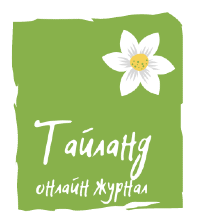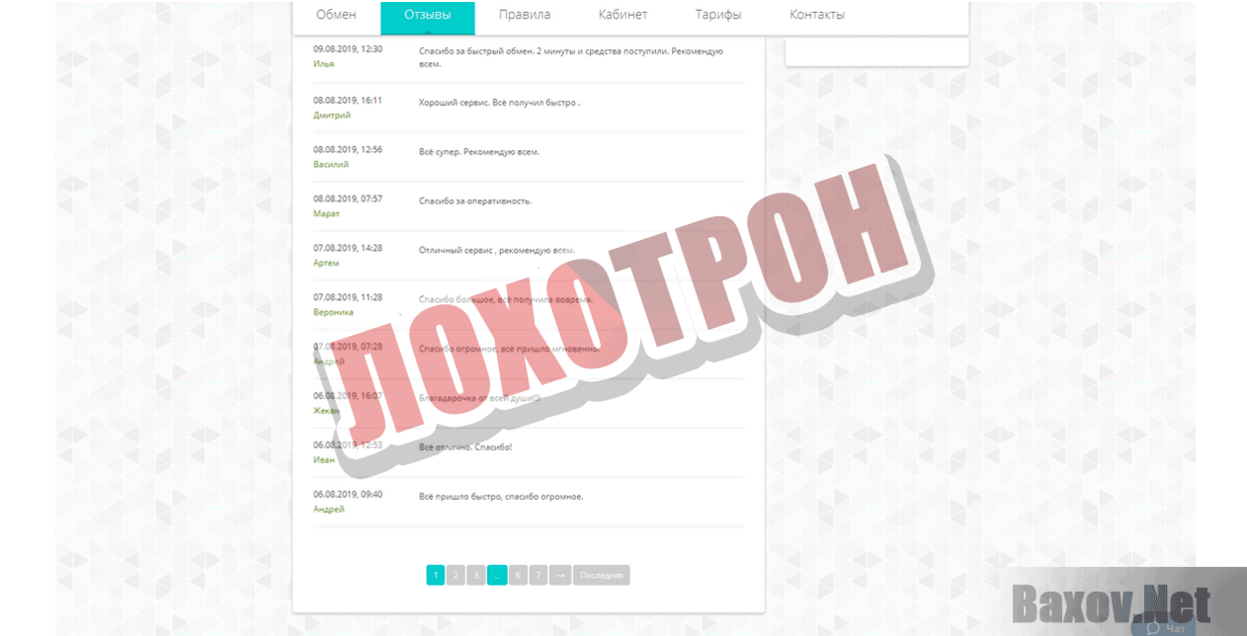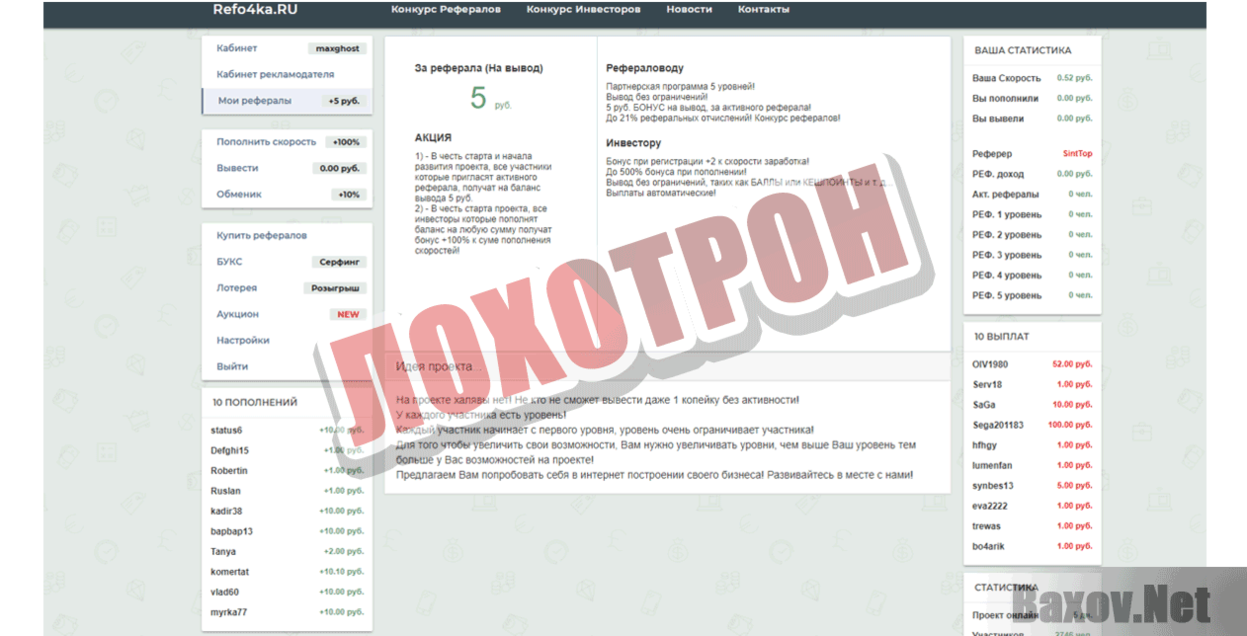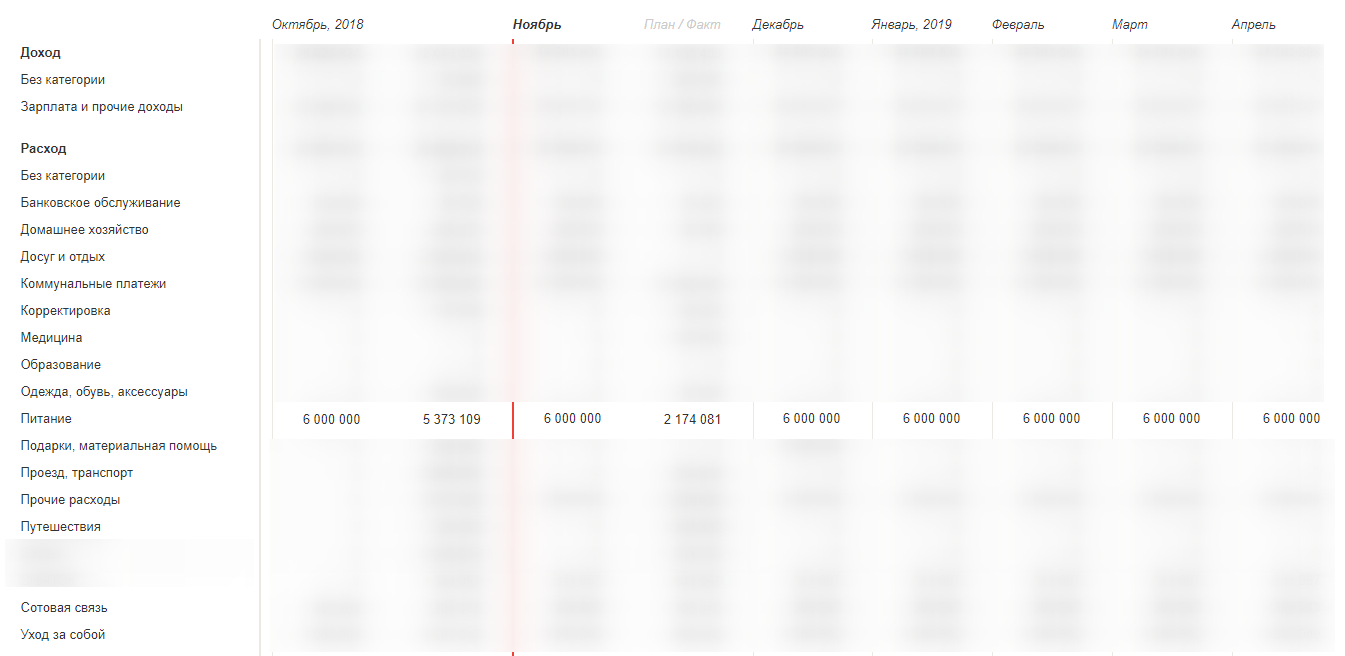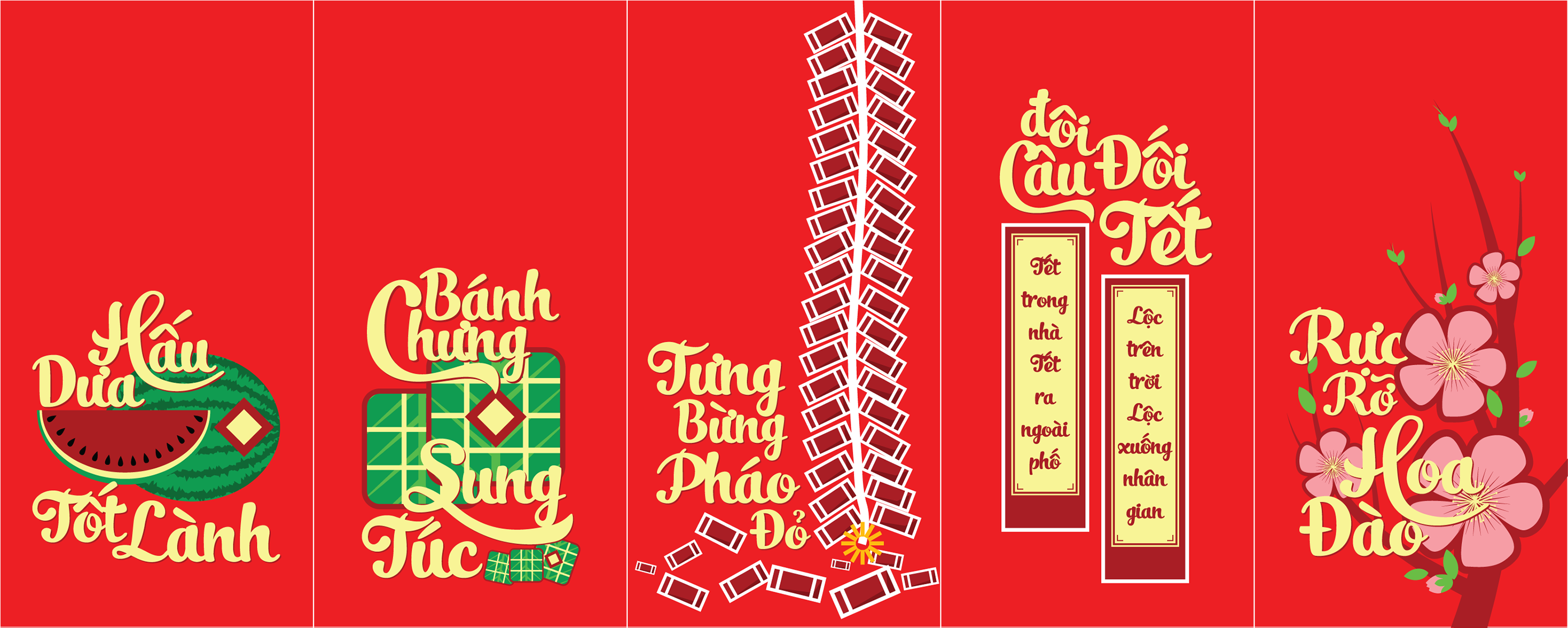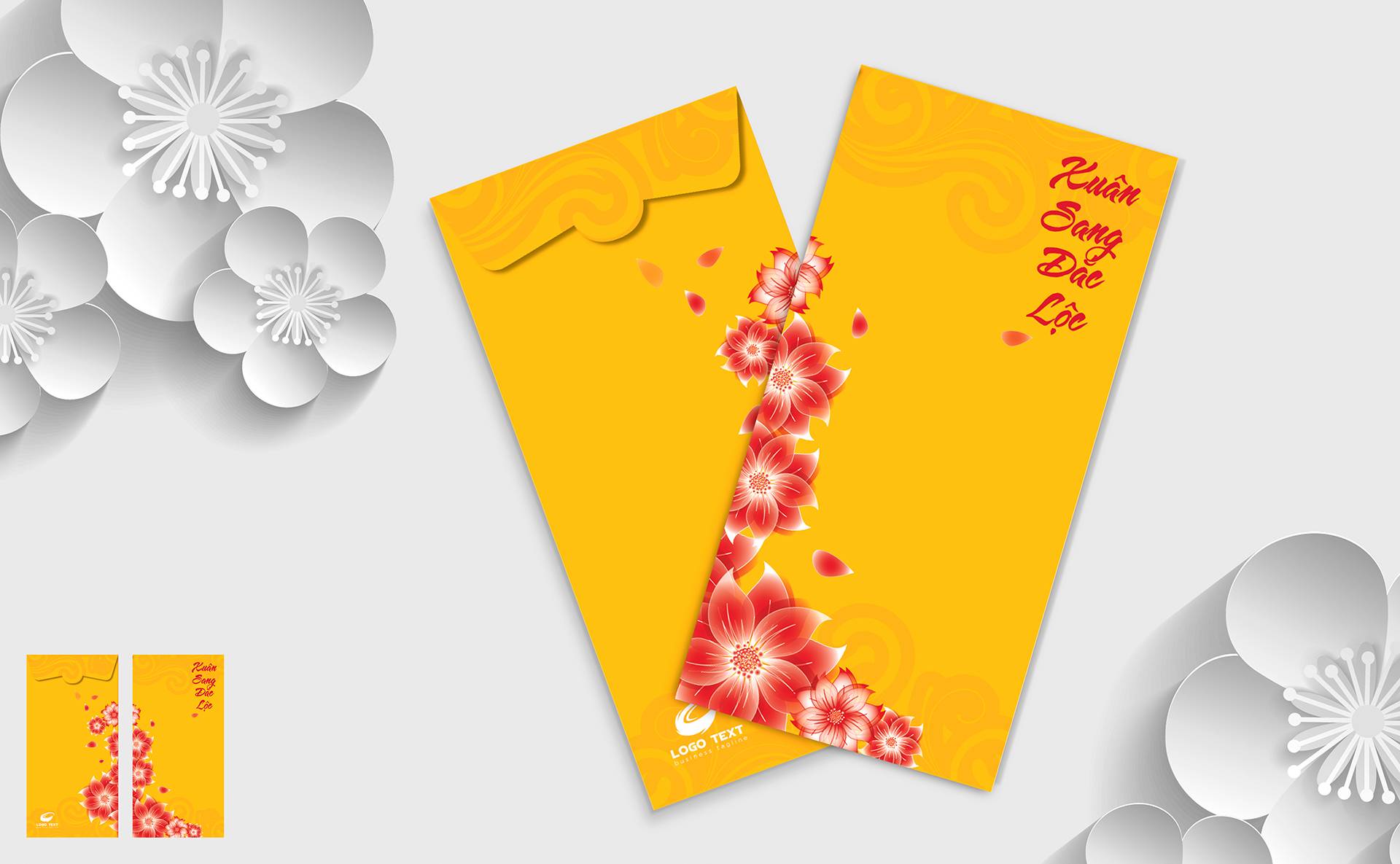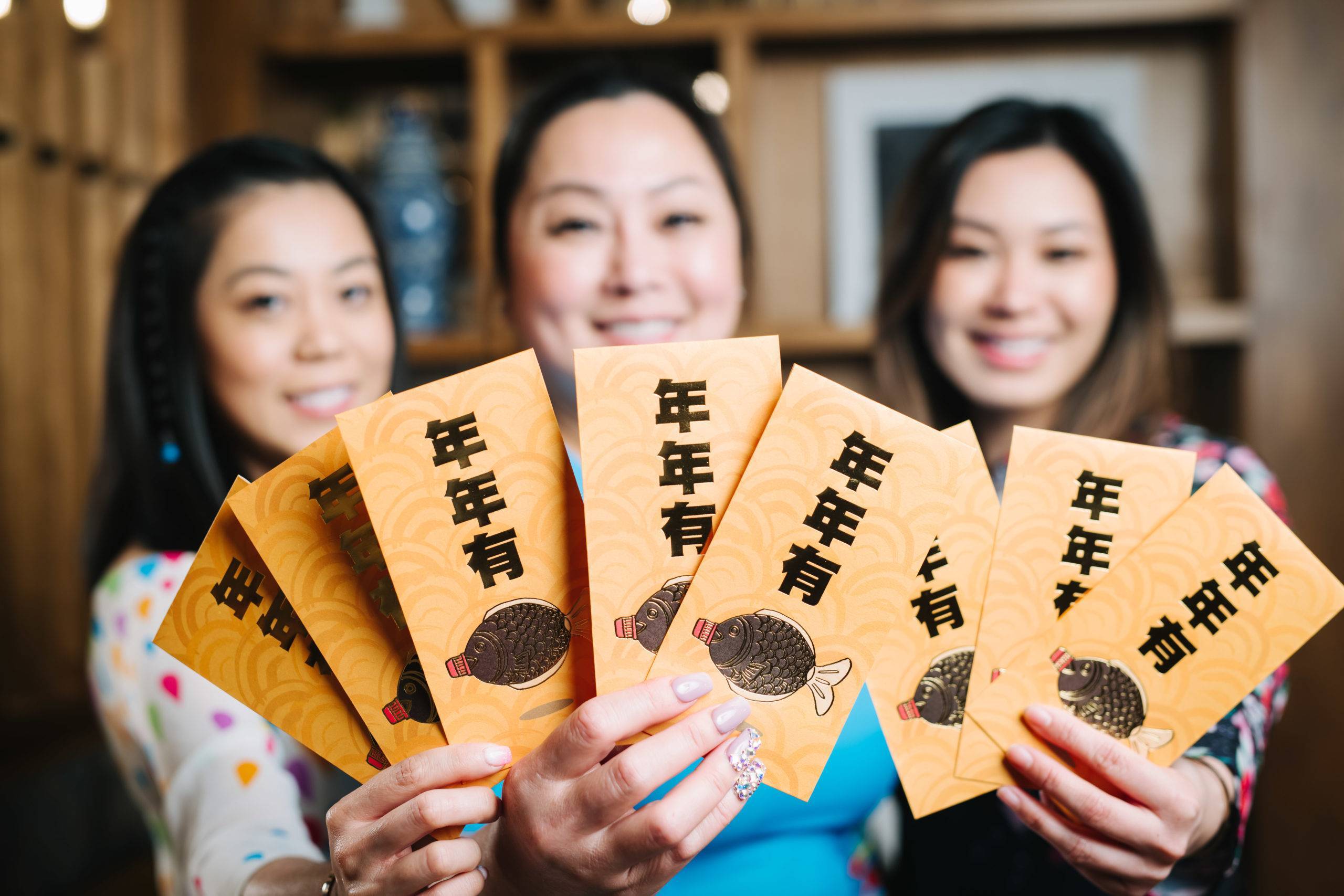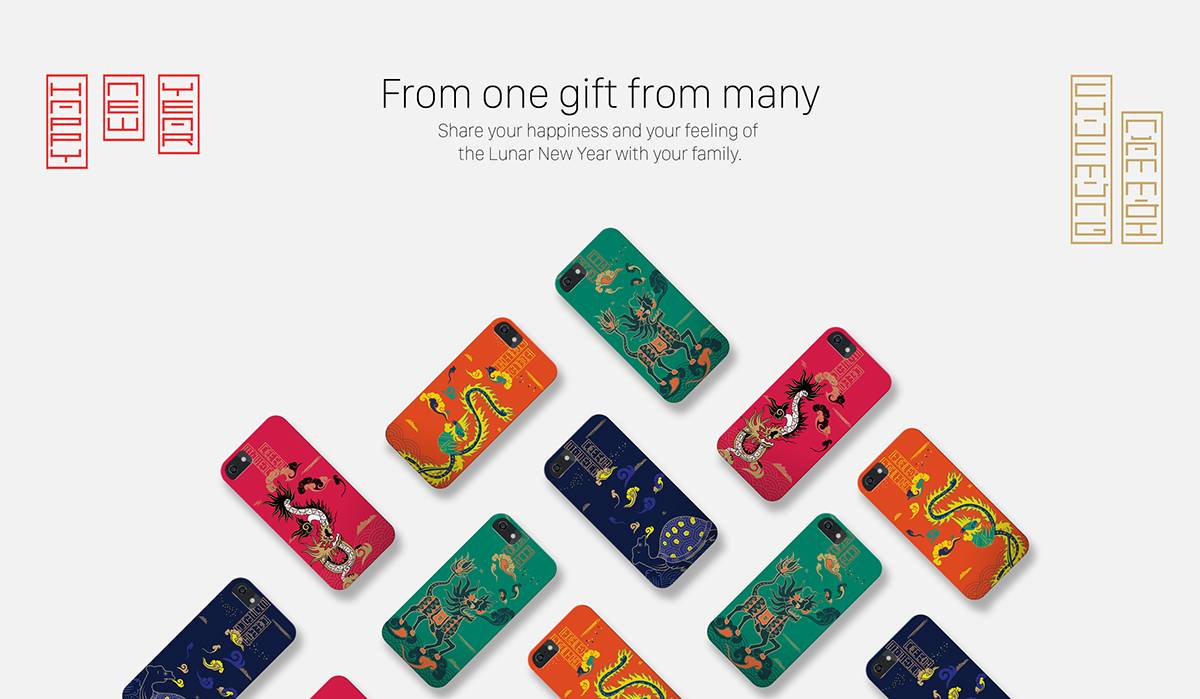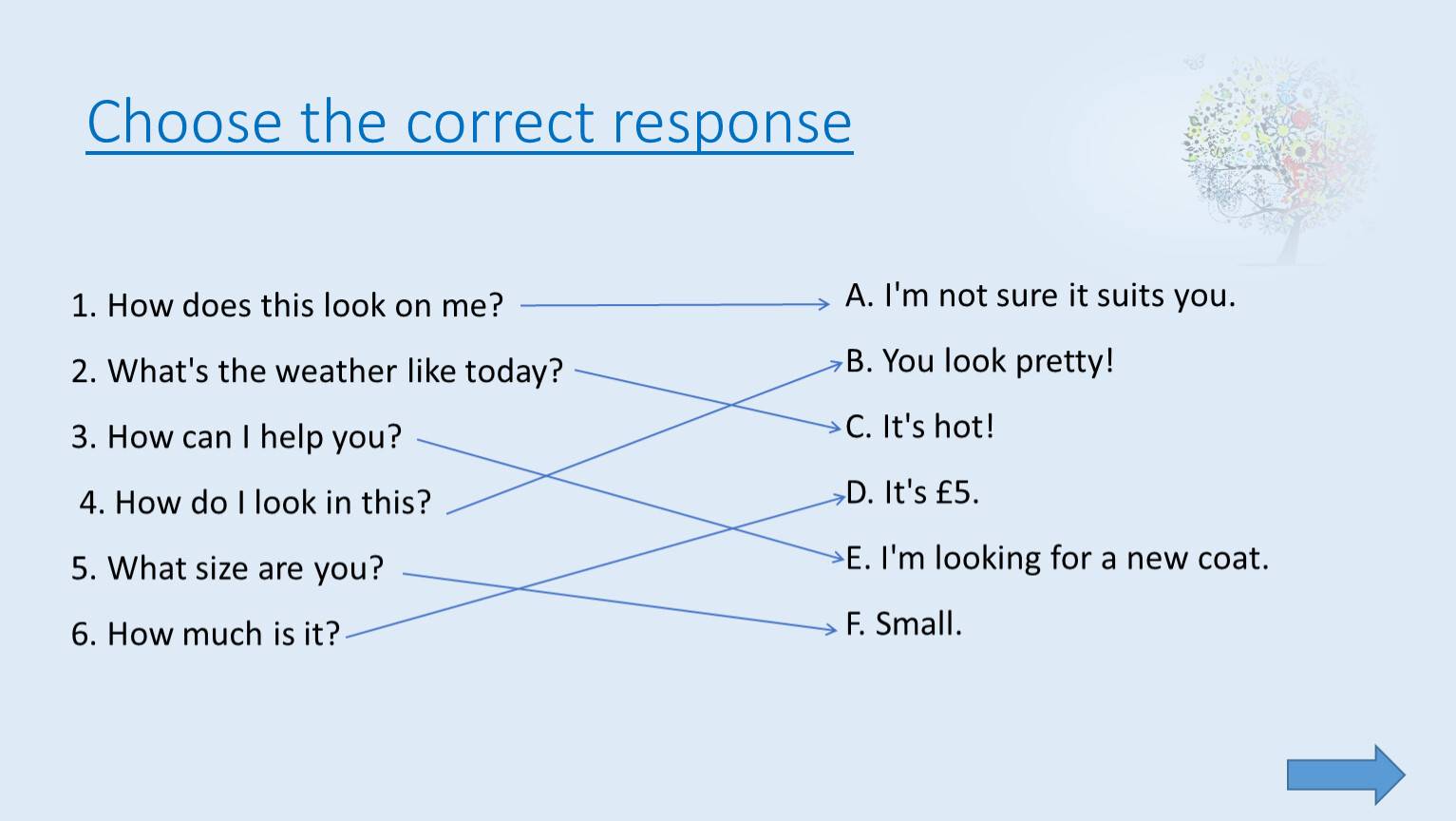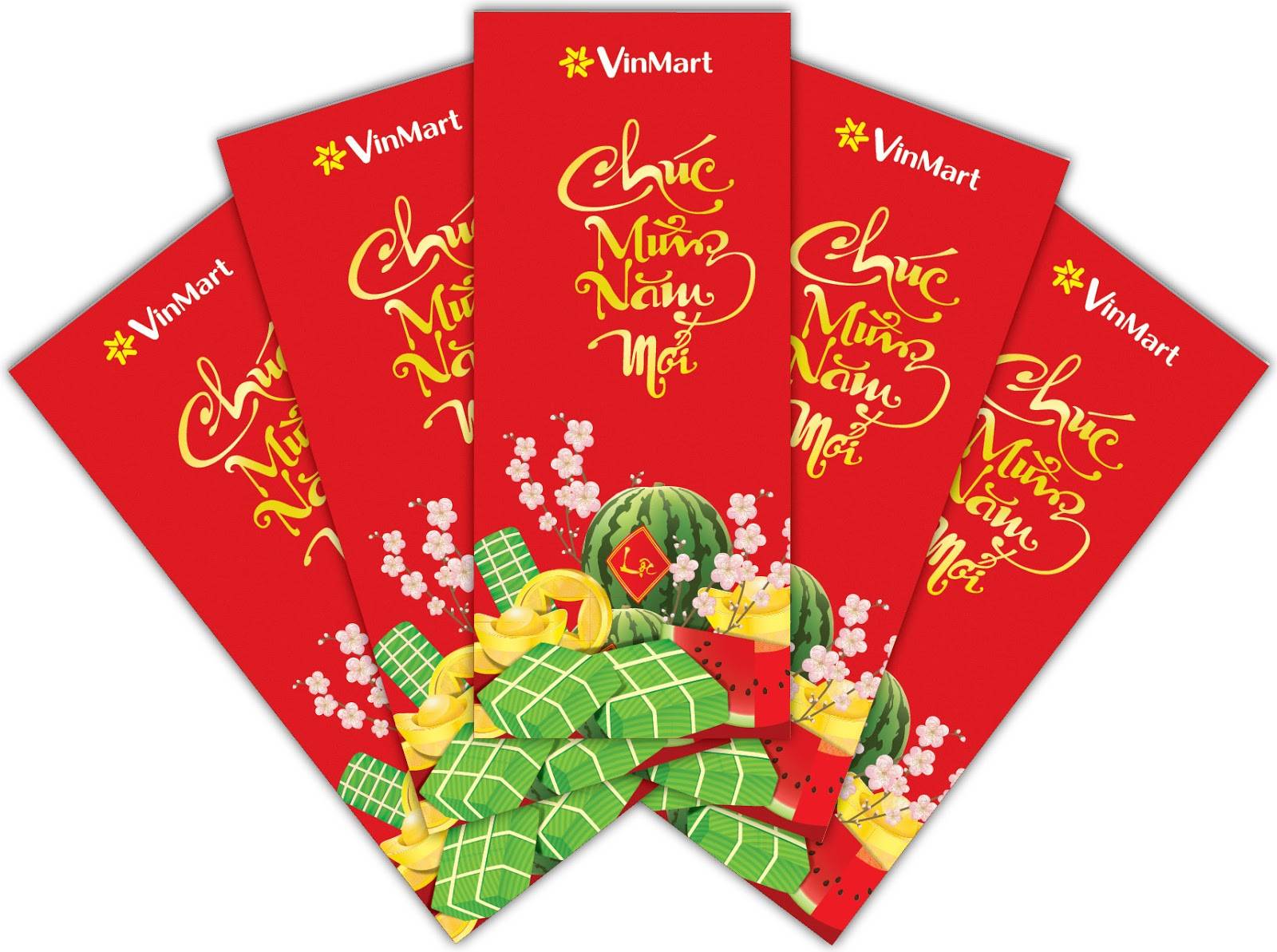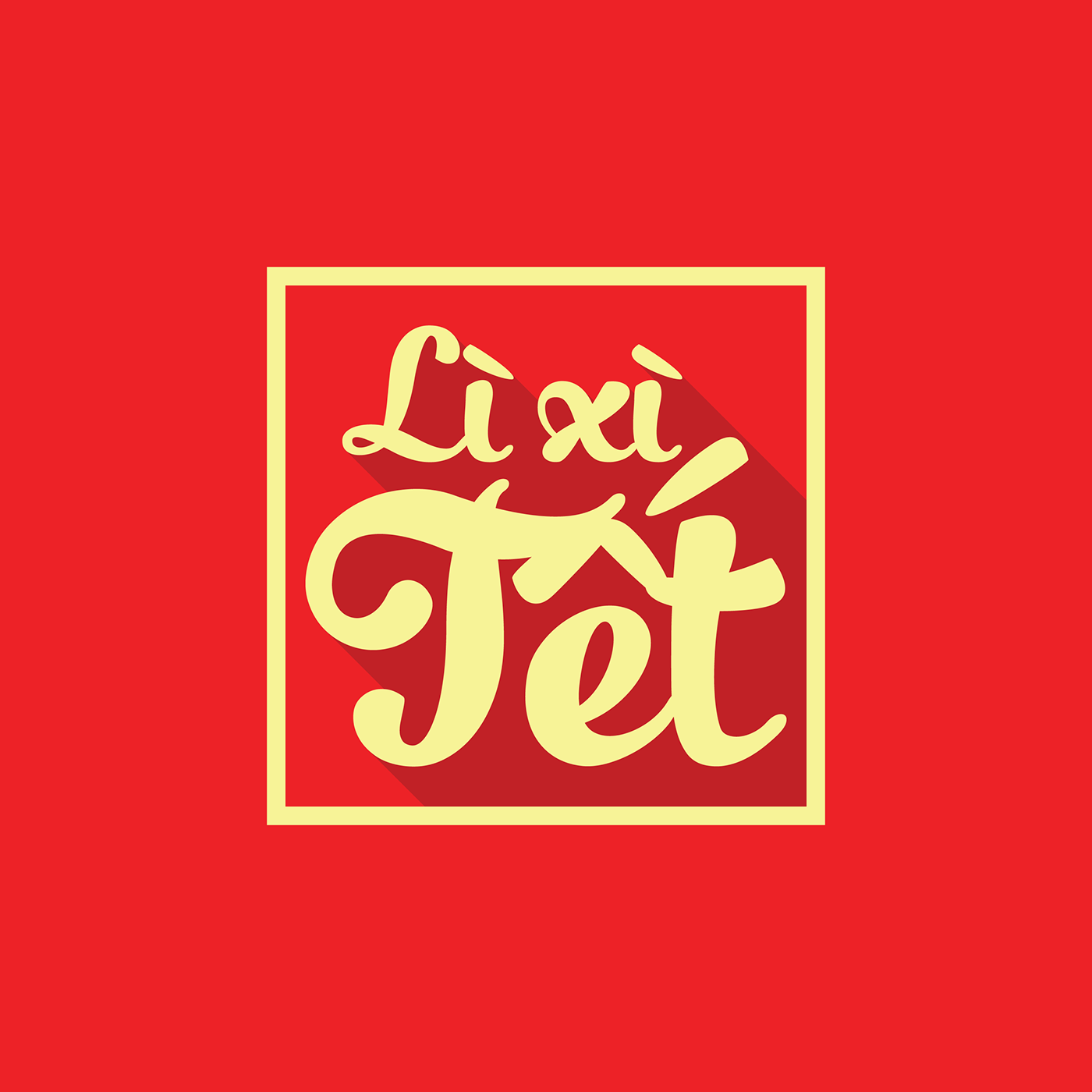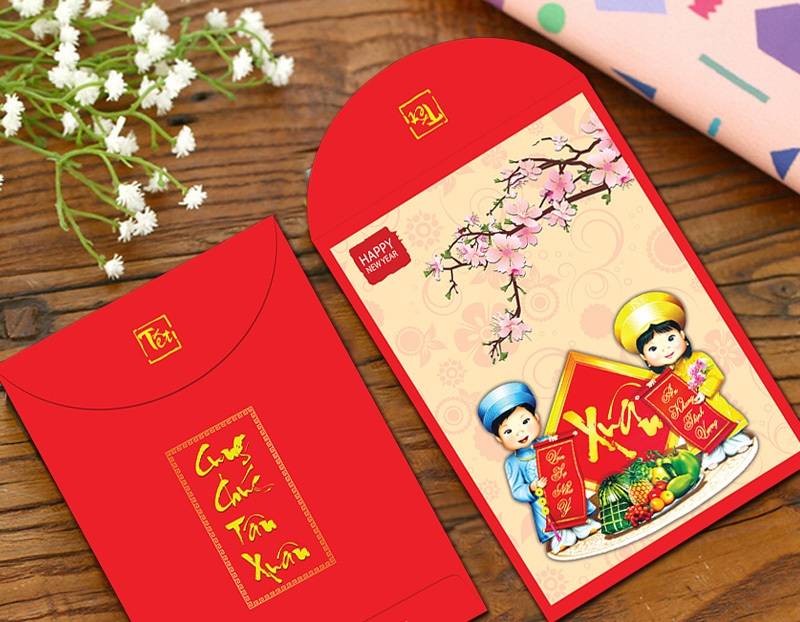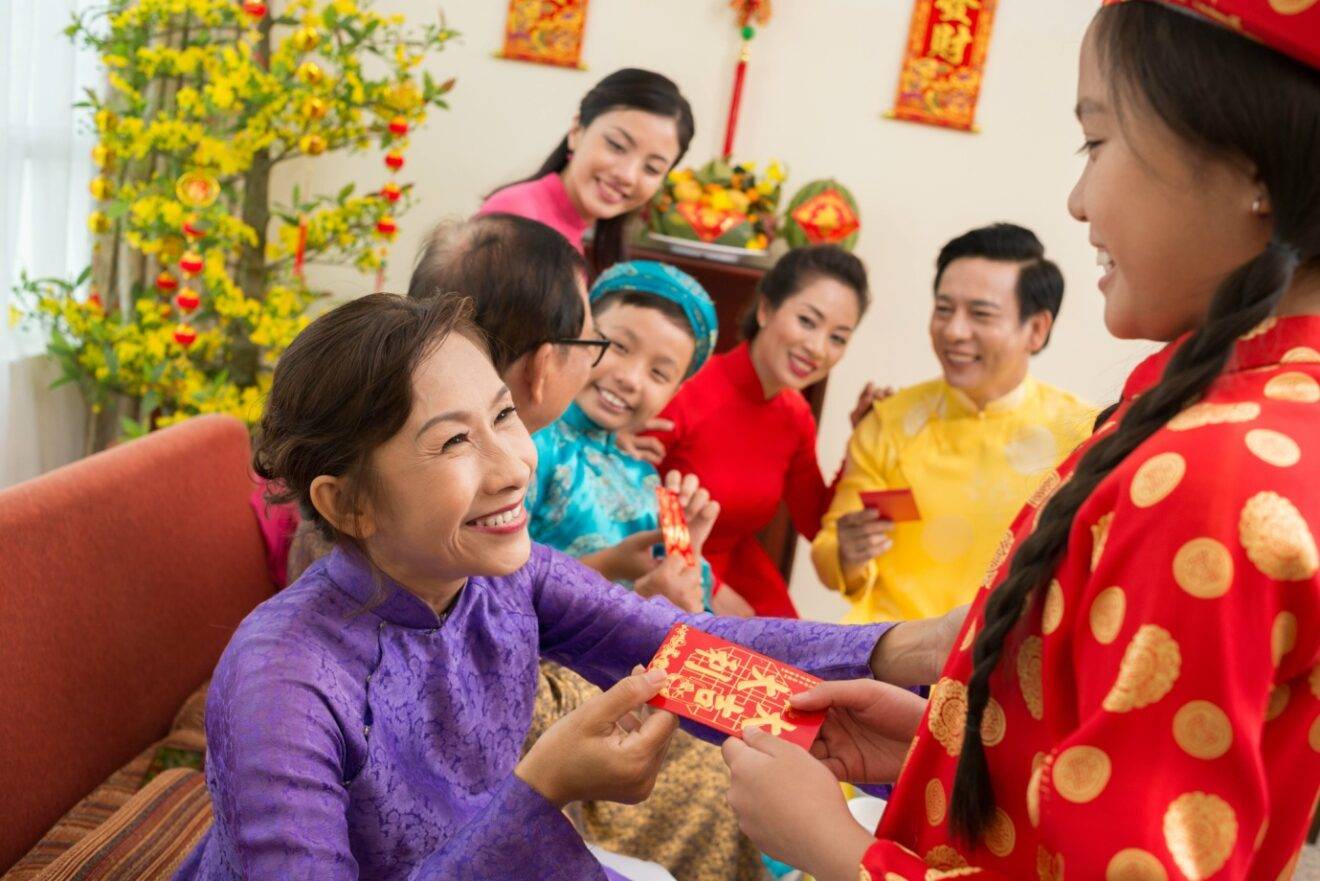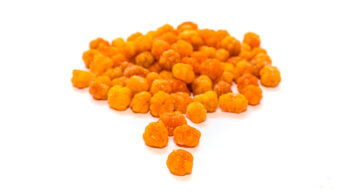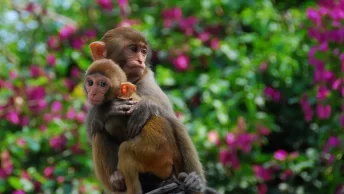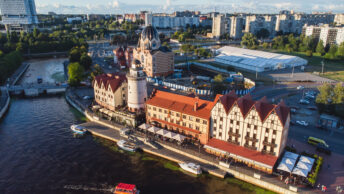Tet Holiday and Zodiac Signs
Vietnamese Tet holiday is based on the Lunar calendar – a calendar that tracks the phases of the moon. The calendar also adopts a set of 12 animals as zodiac signs that are quite similar to other Asian countries. They are Mouse, Ox, Tiger, Cat, Dragon, Snake, Horse, Goat, Monkey, Cock, Dog, and Pig. The cycle of 12 animals is attached to each hour, day, month and year. The Vietnamese believe that each animal possesses a unique characteristic to affect the time that it holds. The Vietnamese New Year holiday in January 2020 marks the year of the Mouse. The astrologers said it will be a year of new beginnings because the Mouse is the first animal in the zodiac signs! There will be new opportunities, love, and money for everyone. 2020 is going to be successful, but make sure that you have prepared well!
From one generation to the next
The custom of lucky money and wishing originated in China, and it’s common in Chinese and Vietnamese households during Lunar New Year.
Over the decades, the nature of wishes has evolved.
There’s a template of wealth, health and happiness wishes like “tien vo nhu nuoc” (“money to flow in like water”) and “suc khoe doi dao” (“great health”). Said year after year, there’s a ring to it in Vietnamese.
They’re easy to spurt and useful for toddlers and acquaintances to copy. But wishes can be personalised — and fun.
Wishes were also more didactic in what the young needed to commit to the family: “you’ve got to do this…”, “you’ve got to do that…”.
Nowadays, they’re more relaxed, or at least more clever, with wrapping up moral instruction in a way for younger generations to still listen.
Wishes for the new year
In my big family, there’s a whole operation to it.
In my grandmother’s living room, seven couples — grandparents, parents, aunties, uncles — sit in a row by one wall as my cousins and I line up to greet each of them.
These days, we’re not little anymore, so we’re literally looking down on them. They sit there, wide-eyed, wide-grinned, waiting to be impressed by us.
We often glance than gaze in our day-to-day, which makes this eye-to-eye moment even more special.
Some wishes are remarkably ridiculous: “I wish for you to nab all the best Groupon coupons!” for that one aunty addicted to deals. Others tug at the heart: “I wish we can spend more time together, grandma, so I can hear your stories of the past.”
Wish, next, wish, next. The shoot and scoot is so loud, we lean in to be heard.
If the elders burst out laughing or tear up, they might even give us a second envelope. But it’s not about the money. (We gamble it all over a dice game of bau cua ca cop afterwards, anyway).
The Wrap Up: Vietnamese New Year Traditions
There are many traditions and customs that Vietnamese people follow during Lunar New Year (Tet Holiday). Before Lunar New Year’s Eve, they clean the house, put up decorations, prepare offerings to the altar for ancestors, and have a family reunion dinner. On Lunar New Year’s Day, Vietnamese will visit paternal family, go to the pagoda, give children lucky money, and request couplets from calligraphy masters. They will spend the rest of the holiday visiting maternal families, teachers, friends, and relatives. I hope this list of the 20 Vietnamese New Year Traditions have helped you understand more about the country’s rich culture and customs.
Although the Vietnamese New Year/ Tet Holiday is one of the best times to visit Vietnam to experience the culture, it can be stressful to plan travel, especially when you don’t know the language. If you need help, feel free to contact me to plan the itinerary and get the best quote for hotels and activities in Vietnam!
Meaning of giving and receiving Lucky Money
“Li Xi” means “Giving money to welcome the new age on the first day of Lunar New Year”. It is a small amount of money that can bring good fortune to the upcoming year. However, “Li Xi” is not limited only on the first day, but can even last to the 9th or 10th day of Tet Festival. The red envelope itself has many functions and meanings. According to traditional beliefs, the money in red envelops, usually in nominal quantity, bears a symbolic meaning while the red color of the envelopes symbolizes good fortune, wealth, a beneficial year, and is supposed to ward off evil spirits. The envelope also keeps the amount money inside secret so the children won’t be jealous of each other if their lucky money is not the same, thereby avoiding unnecessary conflict. Additionally, it is the color of hope and luck. Those who receive lucky money believe that this red envelope will bring them happiness and wealth all year long.
In many Asian traditions, patrons would give “lucky money” as a form of appreciation to people who serve you all year round such as your waiters at your regular restaurants, your baristas at your coffee houses, your security guards who look after your apartment; and may be in your case perhaps your travel consultants, tour guides, drivers, boat rowers etc. for going the extra miles. Lucky money doesn’t have to be Vietnam Dong but whatever currency. Wow, don’t be surprised if you may receive some lucky money in Vietnam as well!
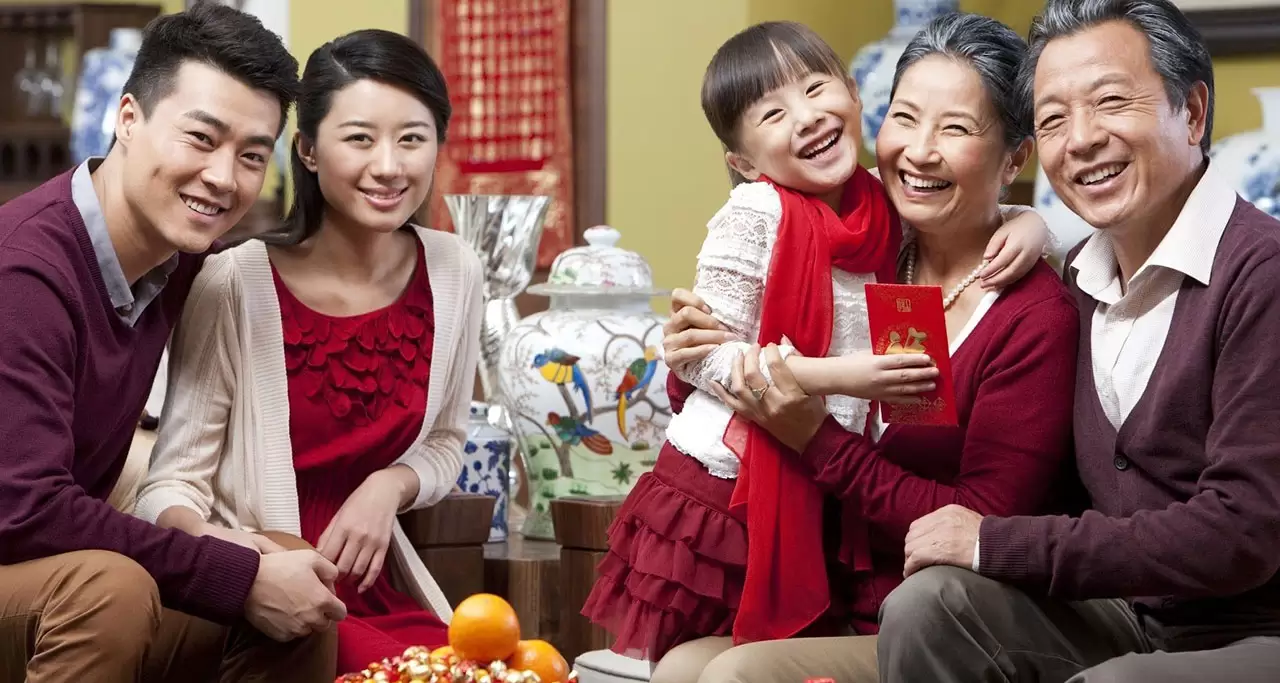
A Vietnamese family reunion on Tet Holiday.
What is Vietnamese New Year Animal Zodiac Sign for 2022?
In Vietnamese culture, each lunar year is associated with an animal sign according to the zodiac cycle, featuring twelve animal signs in the order Rat, Water Buffalo, Tiger, Cat, Dragon, Snake, Horse, Goat, Monkey, Rooster, Dog, Pig. Following that order, the Vietnamese New Year 2021 began the year of the Buffalo and the Vietnamese New Year 2022 commences the year of the Tiger. The cycle repeats every twelve years, so the upcoming years of the Tiger would be 2034, 2046, and so on.
These zodiacs are also associated with five elements in life: gold (metal), wood, water, fire, earth. Every two years of a zodiac sign comes with one of the five elements. For instance, the zodiac sign for 2022 is the Tiger with the gold element.
Per Vietnamese Zodiac Calendar, 2022 is the Year of The Tiger !
Vietnamese people believe that the zodiac and the element of the year will influence the personalities, careers, love, and fortune of the person who was born that year. For example, people born in the year of the tiger are considered risk-takers who have a lot of energy and a lot of luck in life. As a result, they tend to be successful and rich. However, women born in the year of the tiger are believed to have difficulty in choosing life partners because of their strong and independent personalities.
Is Vietnamese New Year Animal Zodiac Sign the Same As Chinese New Year’s?
In most Asian cultures, each lunar year is associated with an animal sign according to the zodiac cycle of twelve years.
- In Vietnam, the 12 Vietnamese zodiac animals in order are: Rat, Water Buffalo, Tiger, Cat, Dragon, Snake, Horse, Goat, Monkey, Rooster, Dog, and Pig.
- In China, Singapore, and Korea, the zodiac animals are: Rat, Ox, Tiger, Rabbit, Dragon, Snake, Horse, Goat, Monkey, Rooster, Dog, and Pig.
As you can see, the Vietnamese New Year 2022 animal sign is the Tiger, which would be the same as the Chinese New Year 2022 animal sign. However, in the following year, the Vietnamese New Year 2023 zodiac sign would be the Cat, while the Chinese New Year 2023’s symbol would be the Rabbit.
How does the Lunar New Year money-giving tradition work?
Ah, yes, those small red envelopes with cash inside. Called lì xì in Vietnamese or hóng bāo in Mandarin, adults give the packets to children in exchange for New Year greetings. Children typically receive envelopes from parents, grandparents, aunts and uncles, but sometimes receive from their parents’ friends, too.
Chinese New Year: What does the year of the rat symbolize and more questions answered
The lucky money inside varies from $1 to several hundred and can reflect numbers of good fortune. The color of the envelope also bears significance, Yiju Huang, assistant professor of Chinese and comparative literature at Fordham University in New York, told The Indianapolis Star of the USA TODAY Network.
“Abundance is associated with the idea of redness,” Huang said. “And the amount of money doesn’t have to be a lot. It’s such a tremendous joy for children, and they use the money to buy candies because they don’t indulge in them usually.”
In South Korea, parents give children New Year’s money, called sebaedon, after children perform a traditional bow and wish them good fortune. The money is often put in silk or cotton pouches embroidered with designs.
Organize Tất Niên – Year-end celebration
Tất Niên – year-end celebration is one of the vital activities to welcome Tet.
Tất Niên is to say goodbye the old year and to push the bad luck away to welcome the new and lucky things.
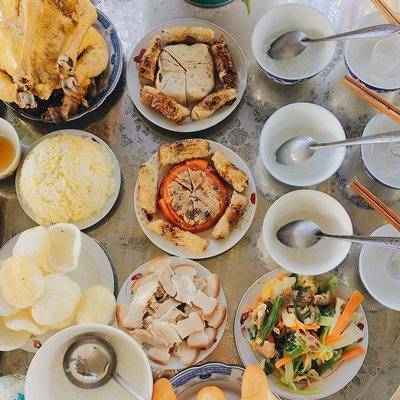 Worshipping Tat Nien | @pi0314.luck
Worshipping Tat Nien | @pi0314.luck
Following the traditional lunar new year, Tất Niên falls on the last day of the lunar year, the 29th or 30th day.
In modern life, many families are busier during the days near Tet for business. Thus, they organize the year-end celebration earlier.
You can find some Tất Niên opened from the 16th day of the last lunar month. And plenty of companies also do this celebration.
If you stay in Vietnam during this period, possibly some neighbors invite you to join the year-end party. When taking part in this party, you do not need to carry any gift, just bring your smiles there.
Guidelines for Tourists When Visiting Vietnam in Tet Holiday 2023
Vietnam Tet Holiday 2023 takes place for 5 days from 22 January to 26 January 2023. Here are some useful tips for tourists if they want to visit Vietnam on Tet Holiday.
- Make sure your travel plans and arrangement are in advance because these days most of the transportation means do not work especially train, bus and renting services of motorbike or car, etc. However, Vietnamese do not travel much during Tet Holiday, as a result, there is no worry about booking a hotel or restaurant.
- As for sightseeing, tourists can not visit some attractions like museums, mausoleums, indoor exhibition places, and art houses since they usually open after at least the first 4 days of the Tet Holiday.
- Fortunately, at that time, in some big cities like Hanoi, and Saigon, the first 3 days of Tet are very quiet without transportation means because a large number of people returning to their hometowns to visit their families already. Therefore, this is a good chance of enjoying the peaceful landscapes.
- Most of the stores will be closed during Tet. Otherwise, a few big markets like Dong Xuan Market and Ben Thanh Market are still open. Moreover, sellers will not raise the price because based on idealist conception, they want to their business be fluent in the early of the year.
Travelling in Vietnam during Vietnamese New Year (Tet)
Tet holiday is one of the best times to visit Vietnam and soak up the festive atmosphere. It is fun to immerse in the culture, try some traditional Tet food, and experience some authentic new year activities. However, there are a few things you should be aware of.
If you are visiting Vietnam during Tet Holiday, you should book everything in advance and also budget for a little bit more to accommodate for the costs caused by raised demand. Expect very long lines and even chaos at the airports, train stations, and bus stations closer to the end of the lunar year as everyone rushes home for a reunion.
Most businesses will close in observance of the national holiday. Hotels and resorts will slow down with less staff on hand. If you travel to Vietnam during this period it is a good idea to check opening times and plan your itinerary carefully.
Here are the top cities in Vietnam you can consider staying in during Lunar New Year for the most available activities.
Hanoi for the Capital’s Celebrations
Hanoi is the capital city of Vietnam, so there will be a lot of activities and fireworks – I used to see at least 8 different firework spots in Hanoi from a balcony in Nga Tu So during Vietnamese New Year 2020. The most well-known spot to watch fireworks is by Hoan Kiem Lake, though you can expect it to be very crowded. Don’t dress too warm if you plan on joining the crowd, it will be very hot and sweaty.
If you want to avoid the crowd while enjoying the best views of fireworks around Hoan Kiem Lake on New Year, you can either book a table at rooftop restaurants or bars nearby, eat at restaurants right by the lake, or stay at hotels near Hoan Kiem Lake. If you stay at Apricot Hotel, you can watch fireworks from the balcony of the room or at the rooftop pool.
Stay at Apricot Hotel for the best views of fireworks around Hoan Kiem Lake on Vietnamese New Year’s Eve!
Hoi An Ancient Town for Traditional Activities
Hoi An is a tourist ancient town close to Da Nang that is well-known for welcoming guests during Lunar New Year. You will see not only the streets lit in traditional lanterns, but also lion dances, traditional folk music, and many other festivities. Shops and restaurants will remain open throughout most of the holiday, although they may close early.
Ho Chi Minh City for Flower Festivals
Ho Chi Minh City, known for the vibrant nightlife and lavish dining spots, won’t let you down for the celebration of Tet. You will find many countdown parties all over the city and fancy cruise dinners by Saigon River. There will also be a Flower Festival on the walking street of Nguyen Hue.
Greet the eve of Tet
The eve of Tet (Đêm Giao Thừa) is the time of bidding farewell to the old year and welcoming the new year, and it is the holiest time.
Most people consider the celebration of new year’s eve is a significant time for all family members.
The Vietnamese people have to organize the offerings to worship in and outdoors, meaning worshipping the ancestors of the family and the outdoor gods.
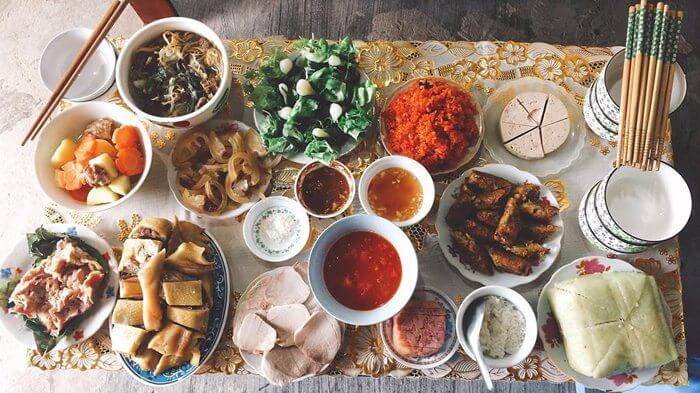 Tet offerings | @iam_phanhlee
Tet offerings | @iam_phanhlee
The offerings are prepared before midnight of the eve. At right midnight, the people start praying.
The offerings of the outdoor altar include a young rooster, Banh Chung, candies, nuts, betel leaves and nuts, fruits, wine, water, incense, and flowers.
After praying outside, the host comes to worship the indoor ancestors. The offering comes less than the outdoor worshipping because the owner prays the ancestor during the year-end celebration.
The indoor offerings can include Banh Chung, fruits, flowers that are kept there for a long time, water, and wine.
Worshipping on new year’s eve is to wish them good luck, prosperity, good health, happiness for family and relatives.
After worship, all members of the family come together to enjoy the party, forming the first important family reunion.
Final Lines
The “Li Xi” custom has changed a little bit to keep up with developing Vietnamese society. However, in old or modern society, “Li Xi” remains as one of the most important customs of Vietnamese people in Lunar New Year. Most importanly, its significant meaning does not lie in the amount of money given but in the hope of the givers for happiness and prosperity for their loved ones in the new year.
Don’t hesitate to plan your next adventure to Vietnam right at the time of our Tet Holiday. Travel Vietnam’s friendly tour guides will help you understand more about “Li Xi” as well as many other interesting customs of Vietnamese people during our New Year occasion.
Last updated on 2021-03-24 21:36:36.
IV – Vietnam New Year traditions and customs
On the Lunar New Year in Vietnam, there are also a number of customs and rituals that have become common standards for any family in all regions of Vietnam.
1 – “Neu” tree to expel evil spirits
“Neu” tree is usually a small bamboo or neohouzeaua tree with relative height and hung many different objects such as betel nut, flute, metal pieces of various sizes. When the wind blows, these objects collide with each other to emit a tinkling sound combined with the sound of firecrackers in order to dispel evil spirits.
According to the conception of the Vietnamese, the tree has the meaning of preventing demons from the East Sea to the mainland where the people live. Decorating trees for Tet Vietnamese New Year is beloved by many children.
2 – Five fruits tray for praying
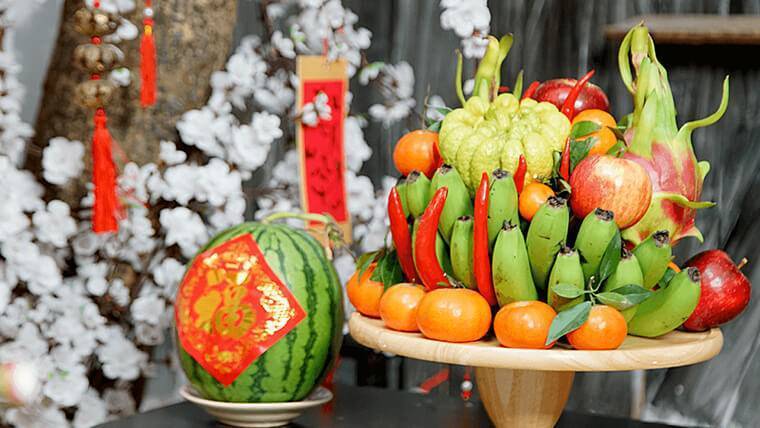
Source: Sunhouse
The fruit tray displayed on the Vietnamese Tet ancestral altar must have all five different fruits. The five fruits represent the five blessings in Buddhism: richness – wealth – long life – health – peacefulness. Some types of fruit that are often in the five-fruit tray in Tet festival in Vietnam include grapefruit – watermelon, persimmon – mandarin, pear, pomegranate, peach, apricot, apple, dragon fruit, coconut, fig, papaya, and mango.
3 – First person to enter the house
According to Vietnamese conception, the first person entering the house in the new year brings luck and convenience to the homeowner in the next year. Therefore, many Vietnamese families often choose the person who matches the head of the household’s age, has a fulfilled and happy life to come to the house after Vietnamese New Year’s Eve for a wish of a peaceful and successful year.
4 – The concept of the first 3 days of the new year
The first 3 days of the new year are believed to have an impact on the householder’s whole year. Therefore, on the Tet holiday, Vietnamese people often give each other best wishes, be good-tempered, and warm to each other. Anything unhappy in the old year is dismissed.
In particular, during the first three days of the Vietnamese New Year Festival, people often abstain from sweeping and dumping garbage. It is believed that if the house is swept in the first three days of Tet, the whole year the family will fall into poverty, the god of wealth will disappear and money will not be able to reach the family.
5 – Choose the date of the first departure
Vietnamese people often choose the good times, good days, and good directions for departing at the beginning of the year in order to bring blessings and prosperity for themselves. This is a feng shui religious activity that is trusted and applied by many Vietnamese people.
6 – Vietnamese lucky money
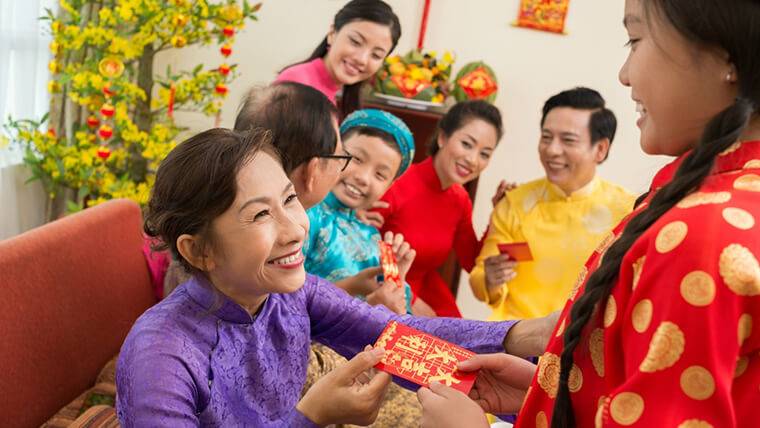
Source: Indochina Voyages
At the beginning of a new year, people will put money in red envelopes called lucky money and give them to children and wish them to have a healthy year, study well. They can also be given to the elders with the wish that their parents live a long, happy life with their family. Besides the desire of bringing good luck to the recipient, lucky money also creates a happy and exciting atmosphere for the first days of the year.
WeChat Red Envelope
2014 Chinese New Year marked the advent of digital red packets on WeChat – the most popular messaging app in China. While watching CCTV New Year Gala, audiences have chances to win cyber red envelopes by shaking their phones ceaselessly. Overnight, WeChat red packets became surprisingly popular nationwide. Instead of the traditional paper envelopes, young people prefer to transfer lucky money directly to their friends and families by smartphone.
Since then, almost all online businesses in China use cyber red packets as a marketing strategy. Spring Festival, a grand occasion for all Chinese, has undoubtedly become a “battleground” for web giants in China, such as Alipay (a major Chinese payment platform established by Alibaba), Tencent (which operates WeChat), and Baidu, making it an annual carnival for people to “grab” digital red envelopes.
The change whereby red envelopes have moved from the real world into digital space has brought new colors to the old tradition of Chinese New Year.
It’s amazing that sometimes just a few yuan (Chinese currency) or even a few cents in the digital red packets can help bring people closer to each other. And even in daily life, the Chinese youth love to exchange red envelopes via smartphones, just for fun.
Despite this, the advent of digital red envelopes is just a marriage of ancient customs and modern technology, rather than a complete divorce from the old tradition.
III – Other activities on Tet Holiday in Vietnam
Activities that usually take place before, during, and after the Lunar New Year include:
1 – Visiting ancestors’ graves
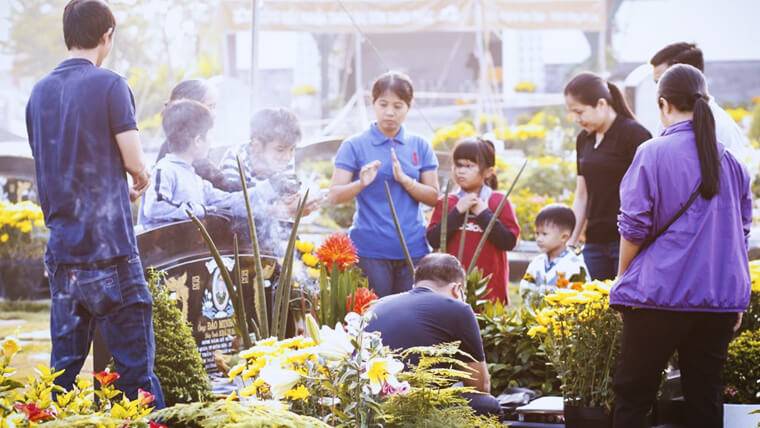
Source: Namphoto
Visiting ancestors’ graves is an activity usually taken at the end of the old year to commemorate the deceased loved ones and wish them a happy and peaceful new year. The main activities of this day are clearing grass, refreshing graves, offering fruits, incense, and white wine, votive papers, etc. This is also one of the activities that clearly shows the tradition of “When eating a fruit, be grateful to the grower” of Vietnamese people.
2 – House decoration before Tet Festival in Vietnam
Cleaning the house to remove old things is also how Vietnamese people throw the sad and unlucky stories of the past year out of the house. At the same time, they decorate their house with fresh flowers, red banners, lanterns, peach blossoms, apricot flowers, chrysanthemums,… These are lucky “mascots” in the new year that each family prepares.
The big streets are also covered with decorative lighting systems with many different colors and shapes. On the last days of the year, when strolling on the street, you can easily feel the eager atmosphere of the Vietnamese people waiting for a new year to come.
3 – Making traditional Vietnamese New Year food
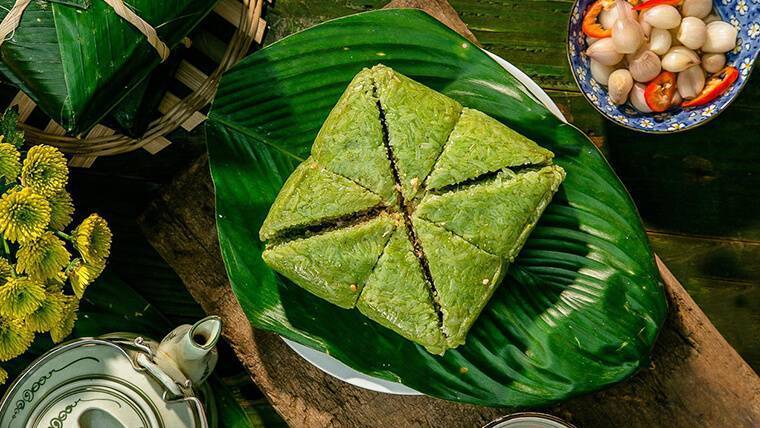
Chung cake – Source: Doanhnhanplus
Tet is also indispensable for Vietnamese traditional dishes such as Chung cake – Banh tet, sautéed sausage, pickles, etc. These are all typical dishes that every family prepares for the Traditional New Year. In addition, some localities also have some unique regional dishes such as “gai” cake, “it” cake, five-color sticky rice, …
The activities related to Chung cake: wrapping, cooking the cake, etc. have become a symbolic feature of the Tet atmosphere in Vietnam.
4 – Visiting pagoda & temple, picking buds early in the year
On the occasion of Vietnamese Tet, everyone converges their mind towards the Buddha with the values of ”Truthfulness – Compassion – Beauty” and wishes to be guided for a peaceful new year, accumulating many blessings for themselves and their relatives.
At the same time, each person will also pick a bud for themselves (a bud of a tree or a flower growing in the temple grounds), then take it home and place it on the ancestral altar with the strong belief that the omen, the blessings that you pray and the Buddha bless will be on the buds and follow you home.
>> It may amaze you: Top 13 most famous Vietnam pagodas from North to South
5 – Vietnamese Lunar New Year games
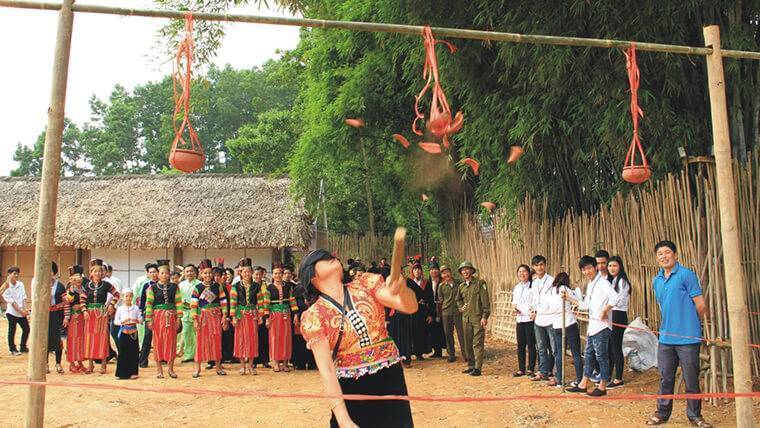
Source: Internet
On the occasion of Tet, each locality organizes folk fun activities such as swinging, tug of war, catching ducks, eateries, … Not only creating a joyful atmosphere. But this is also an opportunity to introduce folk games to the younger generation and preserve the cultural beauty.
Cultural and spiritual activities to visit the pagoda and pray for blessings at the beginning of Vietnamese New Year such as:
Yen Tu Pagoda Festival at Truc Lam Yen Tu Cultural Center, Thuong Yen Cong Commune, Uong Bi City, Quang Ninh Province. From 10 to 30 of lunar March.
– Huong pagoda festival at Huong Son commune, My Duc district, Hanoi. From lunar January 6 – lunar March 30.
– Bai Dinh pagoda festival, far away from Gia Sinh, Gia Vien district, Ninh Binh province. From lunar January 6 – lunar March 30.
– Tay Ho temple festival at No. 52, Dang Thai Mai Street, Quang An Ward, Tay Ho District, Hanoi. From lunar January 15 to 20.
Best Places to Celebrate Vietnamese Tet New Year
Tet New Year is the time when people go back to their parents, family and home villages. This means that it is a lot quieter in the big cities.
1. Hanoi
Since Hanoi is the capital of Vietnam, it offers a wide variety of things to do. Once Tet starts, you can’t go to places like monuments or museums, but you can join in the New Year celebrations, especially around Hoan Kiem Lake. It is especially nice to visit markets, where you will find a lot of flowers and unique food and gifts. The blossoming peach tree is in fact the symbol of Tet in the north, especially of Hanoi. You will see people driving around with these yellow flowers.
2. Ho Chi Minh City
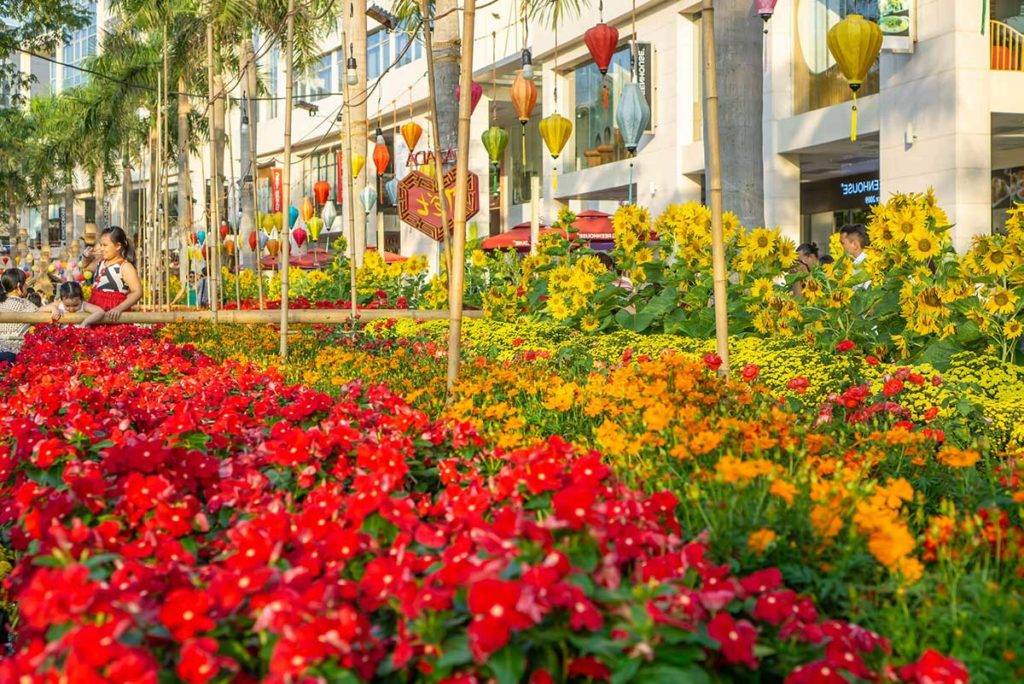
The streets of this city are very empty around this time, but if you are looking for a nightlife during Tet, Saigon is for you. On New Year’s Eve, bars are packed and fireworks light up the streets. Check out the two festivals that are popular with the locals: the Tao Ban Flower Festival and the Nguyen Hue Flower Festival. Besides the beautiful pink flowers everywhere, you can enjoy incredible food, folk music and games. There are also certain spots along the river where boats from the Mekong Delta are moored to bring flowers for Tet.
3. Hoi An
One of the most popular places to celebrate Vietnamese New Year is Hoi An. A great thing is that a lot of shops and restaurants remain open during the Tet Holiday. You have to be in the old town; it has an energetic atmosphere, with lively festivities and street food vendors lit up with lanterns along the way. As the night wears on, the Old Quarter gets busier (more than usual), and all the residents flock to the festival next to the lake. People dressed in national costumes move around the stages to the beat of the drums.
4. Dalat
Dalat is extremely popular among the local residents of Ho Chi Minh City in particular to celebrate Tet. When you go to this city during this period it is useful to book well in advance. There are not many special activities, but it is busy and very cozy everywhere.
4. Ha Giang
The remote province of Ha Giang may not immediately think of celebrating Tet, but it is one of the best places. This is also the time of year when valleys full of flowers are in bloom, which is a beautiful sight. In addition, it is very nice to see how the ethnic minorities (hill tribes) are preparing and celebrating Tet.
The Most Important Traditions in Tet Holiday
The Vietnamese Lunar New Year is divided into three periods. The first part is the preparation week called “Tất Niên”. Next, the celebration on New Year’s Eve is called “Giao Thừa” and the rest of the holiday is called “Tân Niên”. Although each region in Vietnam has slightly different traditions in Tet, all of these customs are to be celebrated.
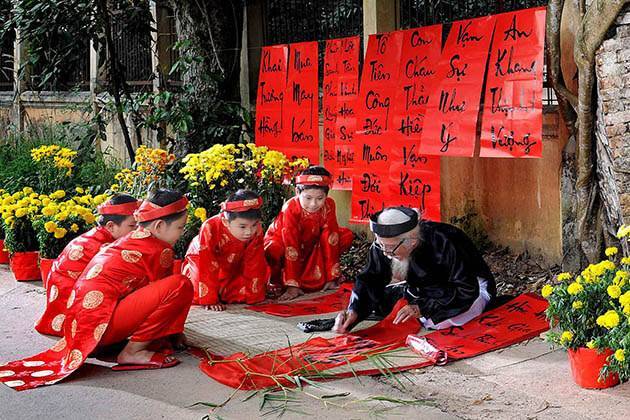
Preparing for Tet Holiday
One or two last weeks of the year is when all the Vietnamese people begin preparing for the Tet Holiday. Every family starts putting on decorations, shops for food and offerings, cooks delicious traditional dishes and welcome their relatives who return home. Parents try to buy the prettiest new outfits for little children to wear on holiday. You will see bustling markets and shopping streets full of people because there are so many things need to be prepared. All of these activities create an atmosphere full of joy and excitement in every house before the Lunar New Year arrives.
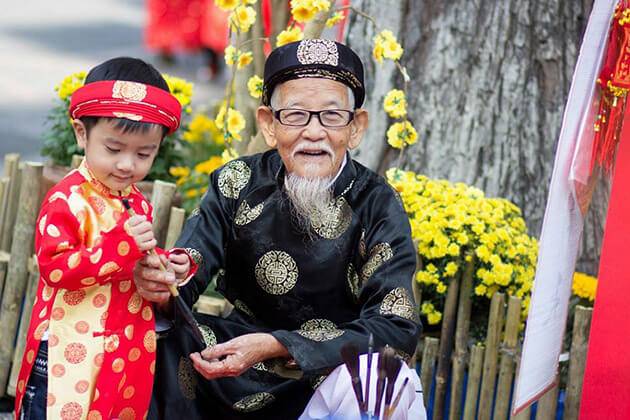
This is also the time for families in Vietnam to express worship to their ancestors by visiting the deceased ones’ graves in their homeland and cleaning the family altar in their home. The family altar is not the only thing being cleaned to prepare for the New Year. In fact, the Vietnamese clean all the rooms in their house so intensively that some even joke that Tet holiday is also a “national house-cleaning festival”. The locals believe that by removing all the dirt and replacing old furniture, the New Year’s luck and fortune would come into the house.
The Cozy and Jolly Vietnam New Year Eve
On the evening of the last day of the year, family members gather to enjoy a banquet to wrap up the night. Everyone is so happy to be with their family at this special moment. And then at the moment of transition, the sky is adorned with bright fireworks. The young often hang out with each other to enjoy these performances while the adults stay in to complete a special ritual to worship the gods and ancestors. They will prepare a table full of offering such as boiled chicken, fruits, flowers, and paper money. At midnight, they will burn the incense and scatter the rice and salt around their house. This tradition is performed in order to pray for peace, health, luck, and fortune to all family members.
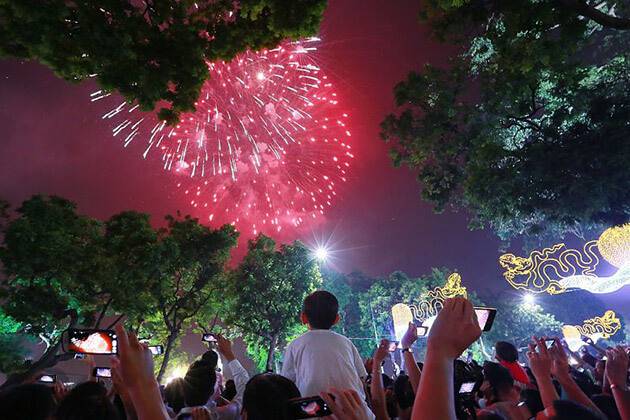 After the firework performances are finished, the young return home in the welcome of their parents. Because in Vietnamese belief, the right person to enter the house first in the new year will bring luck to the host.
After the firework performances are finished, the young return home in the welcome of their parents. Because in Vietnamese belief, the right person to enter the house first in the new year will bring luck to the host.
The Tet Holiday
And then come the morning of the New Year. For the first three days, people often go to friends and relatives’ houses to send wishes or stay at home to welcome their guests. For someone who is often busy year-round or works far from home, this is their only time to be free to see all their friends and family. Laughter and joyful talks are heard everywhere. You will also see that during this time, pagodas and temples everywhere are opened for hundreds of visitors. The Vietnamese believe that it is a sacred time to be delivering your pray to the Buddha and gods.
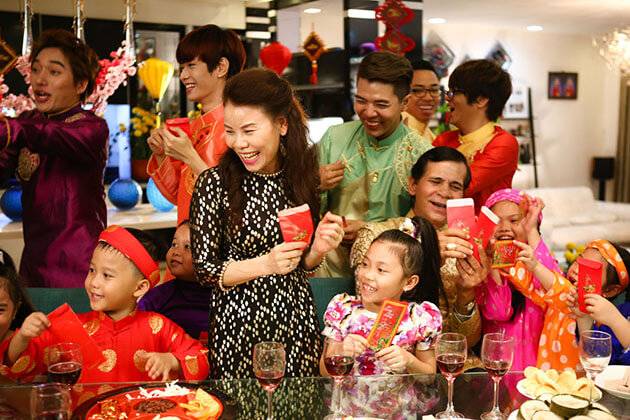
What is the traditional food for Tet festival?
Traditional Food for Tet
You can take part in the Tet festival by trying traditional Vietnamese food! Tet is a time of indulgence with an array of delicacies served in every family, from pork, chicken, and sticky rice to candied fruit. The following three delicious dishes are the most popular ones eaten by Vietnamese people during Tet as part of their celebration.
√ Banh Chung
Only eaten in Vietnam during Tet, this tasty treat is made of tightly-packed sticky rice, which may include either a meat filling or a bean spread. This sticky rice is then traditionally wrapped in banana leaves, to keep the inside fresh for the duration of the festival.
√ Gio or Chag
This Vietnamese ham or sausage is often served with sticky rice during Tet. You can order this festival food in two different ways; Gio means the meat is boiled and if you ask for cha you will receive meat that has been fried.
√ Xoi
This is the Vietnamese classic: sticky rice. Xoi is eaten during many festivals in Vietnam, as it is considered a staple for all meals meant for worshipping the ancestors. It can be made with many different ingredients, including peanuts, mung beans, or fruit.
